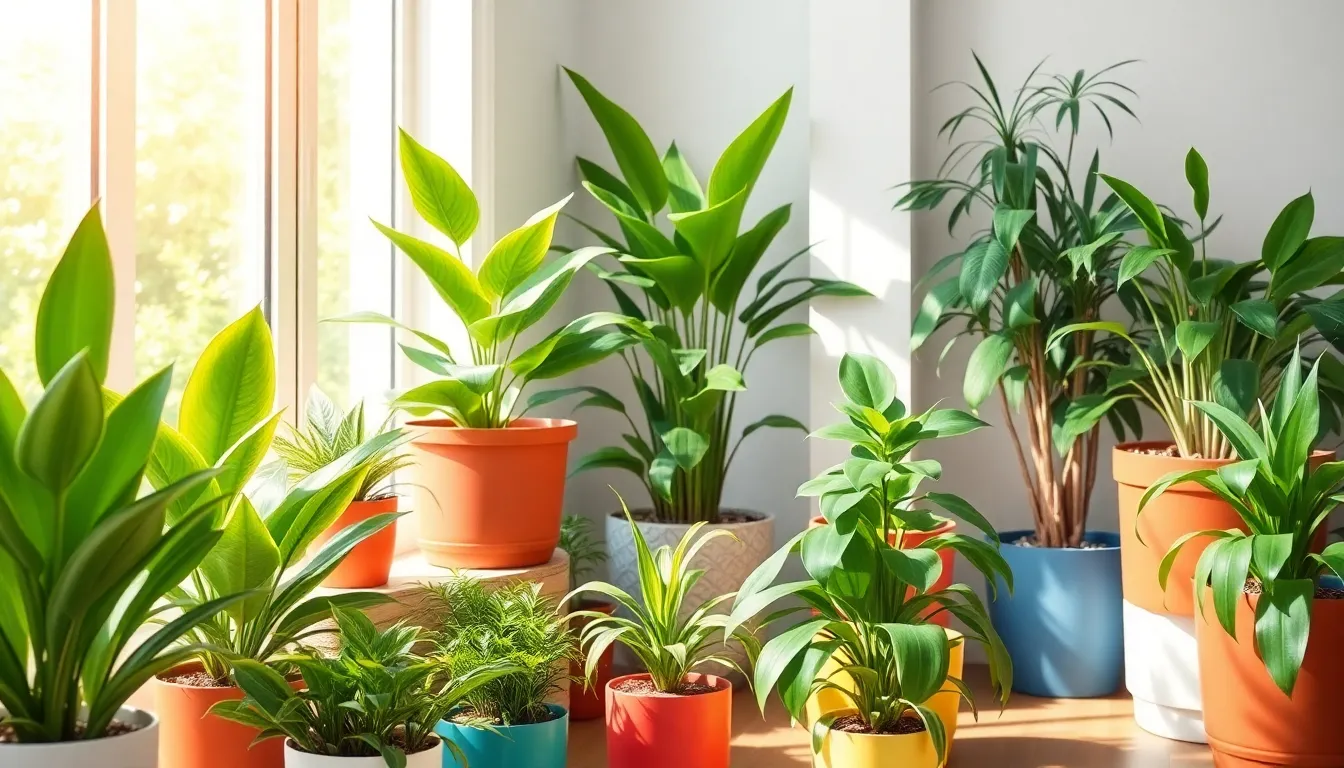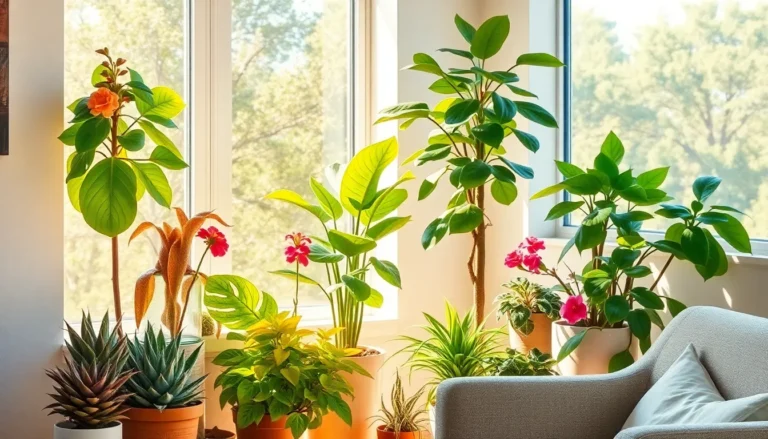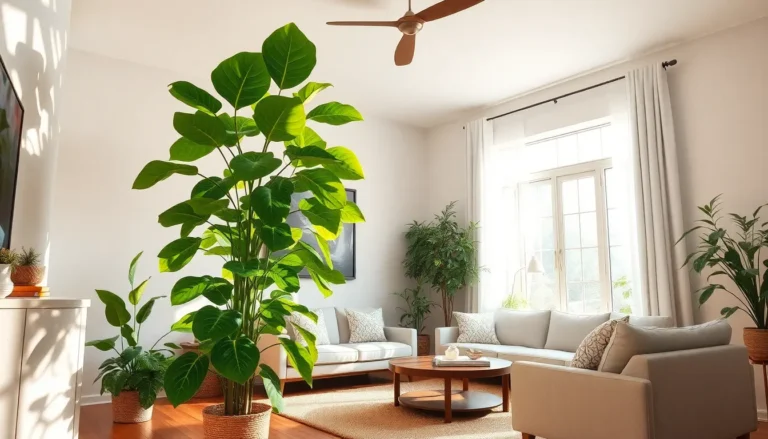Breathing easy in a world filled with pollutants might seem like a fantasy, but it doesn’t have to be. With the right indoor plants, you can transform your space into a clean-air oasis. These leafy companions not only add a splash of green to your home but also work tirelessly to filter out toxins and improve air quality. Who knew that Mother Nature’s little helpers could be so stylish?
Imagine lounging in your living room, surrounded by vibrant foliage while knowing your air is fresher than a mountain breeze. From the resilient snake plant to the elegant peace lily, these plants are like the superheroes of indoor air purification. So let’s dig into the best indoor plants that’ll have you breathing easy and impressing your guests with your newfound green thumb. Who said air quality couldn’t be fun?
Best Indoor Plants for Air Purification
Several indoor plants excel at purifying air and enhancing home environments. The snake plant ranks high among these options, known for its ability to filter formaldehyde and benzene from the air. This hardy plant thrives in low light and requires minimal care, making it ideal for various living spaces.
The peace lily stands out as another excellent choice. It effectively removes toxins such as ammonia and xylene, contributing to cleaner indoor air. This plant features beautiful white flowers that add aesthetic appeal to any room.
Spider plants also contribute to air purification. They can remove pollutants like carbon monoxide and formaldehyde. Easy to grow and propagate, spider plants flourish in indirect sunlight and tolerate a variety of conditions.
Boston ferns are celebrated for their ability to remove pollutants like formaldehyde and xylene efficiently. This lush and lush foliage prefers humid environments, making it ideal for bathrooms and kitchens where moisture is present.
Rubber plants thrive indoors while effectively absorbing toxins like formaldehyde. Their broad, glossy leaves not only enhance air quality but also serve as a standout decorative piece.
Aloe vera, popular for its healing properties, also purifies the air by filtering benzene and formaldehyde. It thrives in bright, indirect sunlight and requires infrequent watering, making it a low-maintenance option.
The bamboo palm is another great selection, filtering out formaldehyde, benzene, and trichloroethylene. It’s a larger plant that can serve as an eye-catching statement in living rooms or spacious areas.
Each of these plants plays a vital role in maintaining healthier indoor air quality while beautifying home spaces. Selecting a combination of these options can create a stylish and clean-air haven.
Benefits of Indoor Plants

Indoor plants serve various benefits, particularly concerning air quality and mental health.
Improved Air Quality
Indoor plants effectively remove harmful toxins from the air. For example, snake plants filter formaldehyde and benzene, both common indoor pollutants. Peace lilies do more than add visual appeal; they remove ammonia and xylene, further purifying the air. Spider plants excel at eliminating carbon monoxide and formaldehyde, making them excellent additions to homes. Boston ferns thrive in humid areas, enhancing air quality while bringing a lush feel. Rubber plants absorb toxins while also functioning as decorative accents. The presence of these plants transforms indoor spaces into healthier environments with cleaner air.
Mental Health Benefits
Indoor plants positively impact mental health and well-being. Research indicates that surrounding oneself with greenery reduces stress and promotes relaxation. Calm and soothing, plants like bamboo palms create a tranquil atmosphere, enhancing mood. Engaging with plants through caring for them fosters a sense of responsibility and purpose. Bright, vibrant flowers, such as those of peace lilies, can lift spirits and brighten rooms. Additionally, viewing nature has a proven calming effect on anxiety levels, contributing to overall mental wellness. Incorporating plants into living spaces translates to tangible benefits for emotional and psychological health.
Top Indoor Plants for Air Purification
Indoor plants significantly enhance air quality while adding visual appeal. Some noteworthy options for effective air purification include:
Spider Plant
Spider plants thrive in various conditions, making them ideal for indoor environments. They efficiently remove carbon monoxide and formaldehyde from the air. Spider plants also produce offshoots, creating a lush appearance. Their resilience aids in adaptability, allowing them to flourish even with minimal care.
Peace Lily
Peace lilies excel at improving air quality by filtering ammonia and xylene. These plants feature elegant white flowers, enhancing decor alongside their functional benefits. Peace lilies thrive in low-light areas, making them suitable for almost any space. Watering them regularly keeps their leaves vibrant and supports optimal air purification capabilities.
Snake Plant
Snake plants effectively purify air by filtering toxins like formaldehyde and benzene. Their striking vertical leaves add a modern touch to interiors. This plant requires minimal maintenance, making it ideal for busy lifestyles. Snake plants also convert carbon dioxide into oxygen at night, enhancing indoor air quality while promoting relaxation.
Bamboo Palm
Bamboo palms are adept at filtering multiple harmful substances, including formaldehyde and benzene. These plants contribute to a tropical aesthetic, creating a soothing atmosphere indoors. They thrive in bright, indirect sunlight and thrive with occasional watering. Bamboo palms also improve humidity levels, promoting a comfortable living environment.
Boston Fern
Boston ferns flourish in humid environments, making them excellent air purifiers for bathrooms and kitchens. They effectively filter out pollutants like formaldehyde and other toxins. Regular misting enhances their lush foliage while supporting air quality. This plant’s ability to absorb moisture contributes to overall humidity, promoting a healthy indoor climate.
Care Tips for Indoor Plants
Maintaining indoor plants involves specific guidelines to ensure their health and effectiveness in purifying air.
Watering Guidelines
Watering techniques vary by plant type but a consistent schedule benefits most indoor plants. Overwatering often leads to root rot; therefore, checking soil moisture before watering is essential. A pot with drainage holes allows excess water to escape, preventing waterlogged roots. Plants generally require watering when the top inch of soil feels dry. Adjust the frequency based on seasonal changes, as growth often slows in winter.
Light Requirements
Light conditions significantly affect plant health. Bright, indirect sunlight suits most air-purifying plants like peace lilies and snake plants. Some plants thrive in low-light environments, while others prefer direct sunlight for optimal growth. Positioning plants closer to windows can enhance their exposure without risking leaf burn. Consider using sheer curtains to filter intense sunlight, ensuring plants receive the right amount of light daily.
Soil and Fertilizer Needs
Soil quality plays a crucial role in plant growth. A well-draining potting mix suits indoor plants, providing necessary aeration and moisture retention. Utilizing organic fertilizer during the growing season promotes healthy growth. Applying fertilizer every four to six weeks allows plants to receive essential nutrients without overwhelming them. Adjusting fertilizer types according to specific plant needs supports optimal air purification capabilities.
Conclusion
Incorporating indoor plants into living spaces not only beautifies the environment but also significantly improves air quality. With options like snake plants and peace lilies, it’s easy to create a healthier atmosphere that benefits both physical and mental well-being. These plants serve as natural air purifiers while offering a sense of tranquility and connection to nature.
By choosing the right plants and following care guidelines, anyone can enjoy the dual advantages of cleaner air and enhanced decor. Embracing greenery in the home is a simple yet effective way to promote a fresher and more inviting living space.




